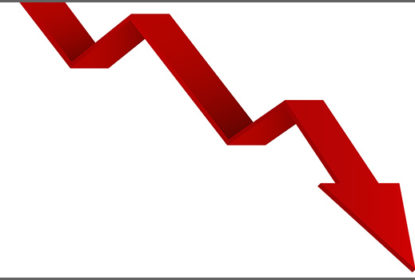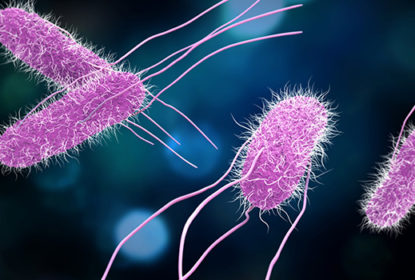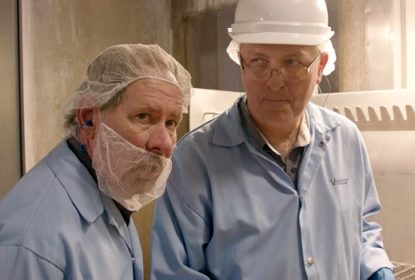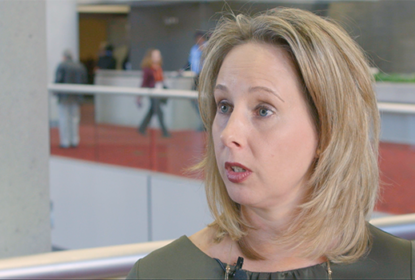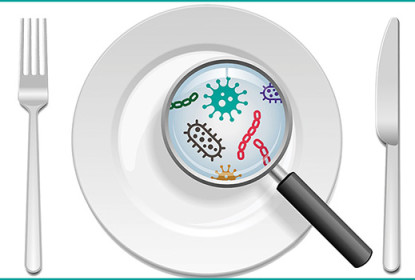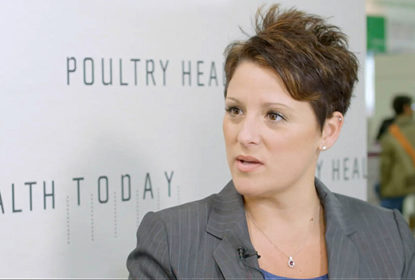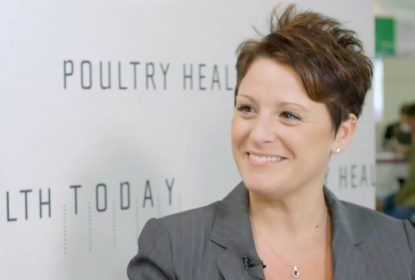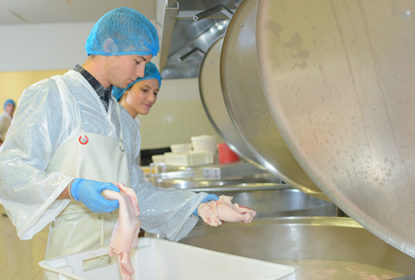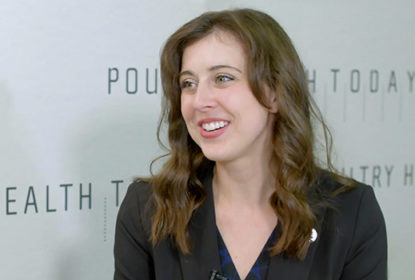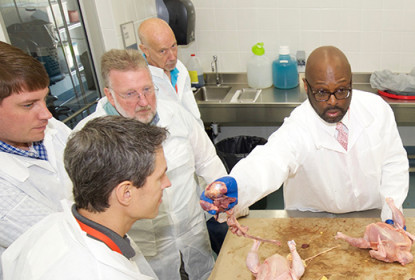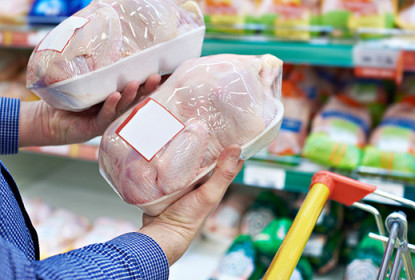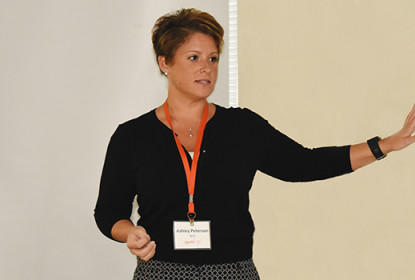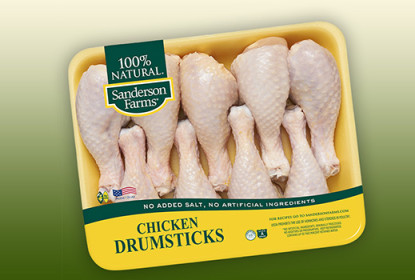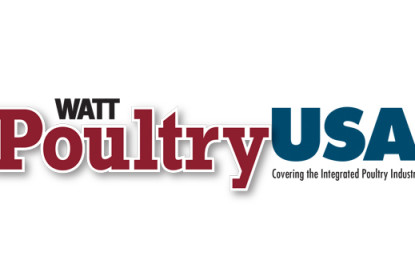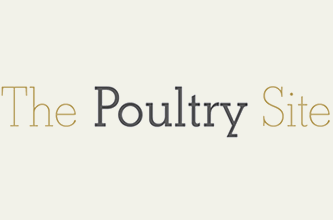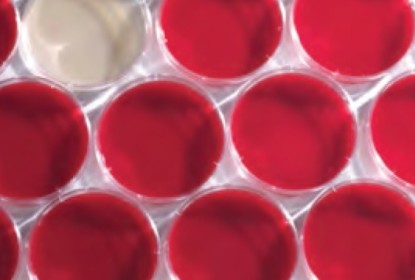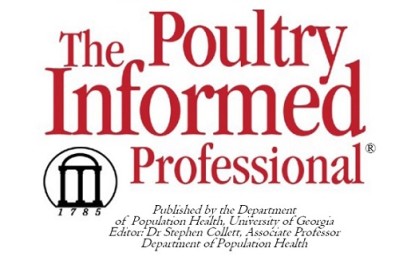Tag Archive: Charles Hofacre, Don Waldrip, food safety, salmonella, salmonella control strategies
... What more can live production do to reduce Salmonella in poultry?
Dec 26, 2019Jennifer GrullonComments Off on What more can live production do to reduce Salmonella in poultry?
Successful Salmonella control throughout live poultry production requires an integrated effort, attention to detail and careful follow-through to help processing plants meet more stringent USDA...... Lightening the load: Teamwork between live production, processing key to reducing foodborne pathogens in poultry
Feb 15, 2019Jennifer GrullonComments Off on Lightening the load: Teamwork between live production, processing key to reducing foodborne pathogens in poultry
While statistics show the US poultry industry has made great strides reducing foodborne pathogens, USDA’s new standards for Salmonella and Campylobacter in chicken parts have made poultry companies...... Modified-live vaccination reduced salmonellosis in Brazilian study
Sep 20, 2018Jennifer GrullonComments Off on Modified-live vaccination reduced salmonellosis in Brazilian study
New research confirms that modified-live vaccines (MLVs) can effectively reduce salmonellosis in broilers — a leading cause of food poisoning in humans.... Special report: Poultry veterinarians teaming up to reduce condemnations, optimize food safety
Sep 18, 2018Jennifer GrullonComments Off on Special report: Poultry veterinarians teaming up to reduce condemnations, optimize food safety
Minimizing carcass condemnations and reducing the load of foodborne pathogens moving from broiler farms into processing might seem like separate production objectives — and they are.... Poultry veterinarians facing new challenges with NAE trend, food safety guidelines
Oct 06, 2017Jennifer GrullonComments Off on Poultry veterinarians facing new challenges with NAE trend, food safety guidelines
The NAE production movement has helped reduce antibiotic use in poultry for good reason, but veterinarians need to make sure the pendulum doesn’t swing so far they have no antibiotics left to...... Hofacre: There’s always room for improvement with Salmonella
Sep 21, 2017Jennifer GrullonComments Off on Hofacre: There’s always room for improvement with Salmonella
Most US poultry companies are doing an “outstanding job” controlling Salmonella, but there's always room for improvement.... New rule, same baseline skews sampling for foodborne pathogens
Aug 03, 2017Jennifer GrullonComments Off on New rule, same baseline skews sampling for foodborne pathogens
Part 2: Last year, the US poultry industry switched from buffered peptone water to “neutralized” buffered peptone to reduce the risk of false negatives when sampling whole chickens and parts for...... US broiler industry steadily reducing incidence of foodborne pathogens
Aug 02, 2017Jennifer GrullonComments Off on US broiler industry steadily reducing incidence of foodborne pathogens
Part 1: The US broiler industry is successfully and steadily reducing the prevalence of Salmonella and Campylobacter on chicken parts since the USDA’s new performance standards took effect.... Reducing food-borne bacterial infections must be team effort
Jul 25, 2017Jennifer GrullonComments Off on Reducing food-borne bacterial infections must be team effort
Increased pressure to reduce bacterial food-borne infections in consumers is affecting poultry production from start to finish, panelists reported at a food safety roundtable, “Lightening the Load:...... Air quality affects S. Heidelberg colonization in broilers
Jun 15, 2017Jennifer GrullonComments Off on Air quality affects S. Heidelberg colonization in broilers
Improving air quality in broiler houses may be an important way to reduce colonization of S. Heidelberg, according to the results of a study presented at the 2017 International Poultry Scientific...... Good communication key to protecting poultry parts during FSIS inspection
Feb 10, 2017Jennifer GrullonComments Off on Good communication key to protecting poultry parts during FSIS inspection
One key to food safety is designing and implementing poultry-inspection protocols that reflect consumer behavior. For example, federal inspectors are refocusing their strategy to address consumer...... Foster Farms’ vet shares tips for managing a food-safety crisis in the poultry industry
Feb 05, 2017Jennifer GrullonComments Off on Foster Farms’ vet shares tips for managing a food-safety crisis in the poultry industry
You’re a veterinarian at a major poultry company that’s just been slammed by a food-safety crisis. Can you imagine what that’s like? And more important, would you know what to do?... Poultry companies need to balance consumer preferences with flock health, welfare and food safety
Dec 19, 2016Jennifer GrullonComments Off on Poultry companies need to balance consumer preferences with flock health, welfare and food safety
Suzanne Dougherty, DVM, a consulting poultry veterinarian based in Alabama, talks with Poultry Health Today about the challenges of reducing or even eliminating antibiotics in broiler production...... NCC scientist: Food safety is everyone’s job
Dec 15, 2016Jennifer GrullonComments Off on NCC scientist: Food safety is everyone’s job
Food safety is a chain stretching from producers to consumers. Ashley Peterson, PhD, of the National Chicken Council, shared her insights at the recent “Young Chicken Gross Pathology Workshop” at...... Coccidiosis, intestinal health and their relationship to pathogen loads of harvested broilers
Jun 30, 2016Jennifer GrullonComments Off on Coccidiosis, intestinal health and their relationship to pathogen loads of harvested broilers
For more than 60 years, antibiotics and synthetic anticoccidials have teamed up to keep coccidiosis under control and produce least-cost meat, said Donald Waldrip, DVM, senior technical services...
Food Safety, Global TOP NEWS, ippe2016- Interviews with experts, News, PHT GLOBAL, PHT US, TOP NEWS, Videos
... Meeting the new USDA/FSIS standards for Salmonella and Campylobacter in poultry
Apr 10, 2016Jennifer GrullonComments Off on Meeting the new USDA/FSIS standards for Salmonella and Campylobacter in poultry
USDA/FSIS issued new standards for Salmonella and Campylobacter in ground poultry meat and chicken and turkey parts.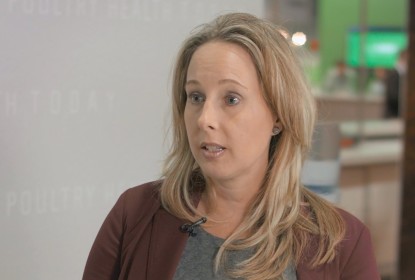
Antibiotic-free, Flock welfare, Food Safety, ippe2016- Interviews with experts, PHT GLOBAL, PHT US, Videos
... Balancing consumers’ preferences with flock health, welfare and food safety
Feb 11, 2016Jennifer GrullonComments Off on Balancing consumers’ preferences with flock health, welfare and food safety
Suzanne Dougherty, DVM, a consulting poultry veterinarian based in Alabama, talks with Poultry Health Today about the challenges of reducing or even eliminating antibiotics in broiler production...... Salmonella prevention requires teamwork between production and processing
Jan 16, 2016Jennifer GrullonComments Off on Salmonella prevention requires teamwork between production and processing
Identifying the pathways of Salmonella contamination has poultry producers and processors looking for answers in every step of the process from the farm to table.... Sanderson CEO gives three reasons for sticking with antibiotics
Jul 18, 2015Jennifer GrullonComments Off on Sanderson CEO gives three reasons for sticking with antibiotics
Count Joe Sanderson Jr., chairman and CEO of Sanderson Farms, as being on the opposite side of the current movement to shift away from the use of antibiotics in poultry production, according to a...... USDA proposes new measures to reduce Salmonella, Campylobacter
Apr 06, 2015Jennifer GrullonComments Off on USDA proposes new measures to reduce Salmonella, Campylobacter
The USDA’s Food Safety and Inspection Service (FSIS) on January 21 proposed new federal standards to reduce Salmonella and Campylobacter in ground chicken and turkey products as well as raw chicken...... Isolation of Campylobacter from the circulating blood of broilers
Feb 26, 2015Jennifer GrullonComments Off on Isolation of Campylobacter from the circulating blood of broilers
From a poultry processing viewpoint, Campylobacter presence in circulating blood of market-age broilers may increase the likelihood of cross-contamination between birds during slaughter.... Farmer voice matters in building consumer trust
Feb 16, 2015Jennifer GrullonComments Off on Farmer voice matters in building consumer trust
Farmers will need to engage in conversations with consumers for the long term if they are to build trust in today’s food system.... Improving Rapid Detection Methods for Foodborne Pathogens
Jan 30, 2015Jennifer GrullonComments Off on Improving Rapid Detection Methods for Foodborne Pathogens
Researchers have developed a microfluidic device that exploits cell movement to separate live and dead bacteria during food processing.... US Poultry Industry Responds to New Food Safety Proposal
Jan 28, 2015Jennifer GrullonComments Off on US Poultry Industry Responds to New Food Safety Proposal
The industry body, the National Chicken Council and one poultry processor have welcomed the aims of the recently announced proposal to reduce Salmonella and Campylobacter on poultry parts... S. Heidelberg colonization reduced with in-feed treatment
Jan 28, 2015Jennifer GrullonComments Off on S. Heidelberg colonization reduced with in-feed treatment
Broilers that received bacitracin methylene disalicylate (BMD®) plus a probiotic selected for its ability to survive the feed-pelleting process had a markedly lower prevalence of Salmonella...... USDA announces new inspection system for poultry products
Sep 26, 2014Jennifer GrullonComments Off on USDA announces new inspection system for poultry products
The US Department of Agriculture's (USDA) Food Safety and Inspection Service (FSIS) last week announced a critical step forward in making chicken and turkey products safer for Americans to eat.... USDA announces new inspection system for poultry products
Sep 26, 2014Jennifer GrullonComments Off on USDA announces new inspection system for poultry products
The US Department of Agriculture's (USDA) Food Safety and Inspection Service (FSIS) last week announced a critical step forward in making chicken and turkey products safer for Americans to eat.... Campylobacter research reveals potential for poultry vaccine
Sep 19, 2014Jennifer GrullonComments Off on Campylobacter research reveals potential for poultry vaccine
Researchers at the USDA Richard B. Russell Agricultural Research Center have purified proteins from Campylobacter and tested them for their potential use as vaccines.... Experimental and applied approaches to control Salmonella in broiler processing
Mar 17, 2014Jennifer GrullonComments Off on Experimental and applied approaches to control Salmonella in broiler processing
By Dr. Mark E. Berrang USDA—Agricultural Research Service, Russell Research Center, Athens, GA


